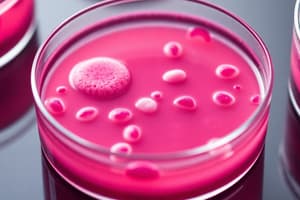Podcast
Questions and Answers
What is the primary function of agar in a culture medium?
What is the primary function of agar in a culture medium?
To act as a solidifying agent, allowing the medium to solidify at a temperature below its melting point.
What is the minimum temperature required to melt agar and put it into solution?
What is the minimum temperature required to melt agar and put it into solution?
100°C (boiling)
What is the purpose of sterilization in microbiological culture preparation?
What is the purpose of sterilization in microbiological culture preparation?
To completely remove or destroy all living cells, viable spores, and viruses from a medium or object.
What are the standard conditions for autoclave sterilization of culture media?
What are the standard conditions for autoclave sterilization of culture media?
What is the primary component of glucose-tryptone-yeast extract (GTYE) medium that provides a source of amino acids?
What is the primary component of glucose-tryptone-yeast extract (GTYE) medium that provides a source of amino acids?
What is the purpose of adding potassium phosphate to GTYE medium?
What is the purpose of adding potassium phosphate to GTYE medium?
At what temperature is the GTYE medium cooled to before pouring into plates?
At what temperature is the GTYE medium cooled to before pouring into plates?
What is the importance of using aseptic technique during the preparation of GTYE medium and pour plates?
What is the importance of using aseptic technique during the preparation of GTYE medium and pour plates?
What are the essential chemical elements required by microorganisms for growth, and where do they obtain them from?
What are the essential chemical elements required by microorganisms for growth, and where do they obtain them from?
What are the four key components that a culture medium must provide to support microbial growth?
What are the four key components that a culture medium must provide to support microbial growth?
Distinguish between defined and complex culture media, highlighting their uses and limitations.
Distinguish between defined and complex culture media, highlighting their uses and limitations.
What is the purpose of a selective culture medium, and how does it differ from an enrichment medium?
What is the purpose of a selective culture medium, and how does it differ from an enrichment medium?
How does a differential culture medium differ from other types of culture media, and what is its purpose?
How does a differential culture medium differ from other types of culture media, and what is its purpose?
What determines the selectivity of an enrichment culture, and is it solely based on the chemical composition of the medium?
What determines the selectivity of an enrichment culture, and is it solely based on the chemical composition of the medium?
What is the significance of pH stability in a culture medium, and how is it achieved?
What is the significance of pH stability in a culture medium, and how is it achieved?
Study Notes
Microorganisms' Nutritional Requirements
- Microorganisms require the same chemical elements for growth as higher forms of life
- Nutritional and environmental needs must be met for effective culture medium preparation
Types of Culture Media
- Defined medium (synthetic medium): has known components, useful for studying metabolism of a microorganism
- Complex medium (undefined medium): contains ingredients of unknown composition, useful for providing a rich and complete medium
- General purpose medium: allows growth of many microorganisms
- Enrichment medium: selects for microorganisms with the highest growth rate
- Selective medium: favors growth of a particular organism
- Differential medium: distinguishes between different groups of bacteria
Agar as a Solidifying Agent
- Agar is a complex polysaccharide extracted from red algae
- It is attacked by relatively few bacteria
- Agar is melted at 100°C (boiling) and remains liquid until the temperature falls to about 44°C
Sterilization of Culture Media
- Sterilization is the complete removal or destruction of all living cells, viable spores, and viruses from a medium or object
- Physical agents such as heat, filtration, and radiation are commonly used for sterilization
- Autoclave sterilization: uses saturated steam under high pressure, standard conditions are 121°C at 15 psi for 15 minutes
Preparation of Glucose-Tryptone-Yeast Extract (GTYE) Medium
- GTYE medium supports growth of a wide variety of bacteria
- Components include glucose, tryptone, yeast extract, and potassium phosphate in a buffered solution solidified with agar
- Beef extract contains amino acids, peptides, nucleotides, organic acids, vitamins, and minerals
- Tryptone is mainly a mixture of peptides and amino acids
- Yeast extract is a source of B vitamins, nitrogen, and carbon compounds
Studying That Suits You
Use AI to generate personalized quizzes and flashcards to suit your learning preferences.
Description
This quiz covers the importance of culture media in meeting the nutritional requirements of microorganisms. It discusses the diversity of environmental components that provide essential elements for growth.




